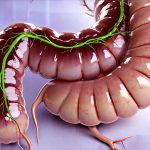The intricate ecosystem within our digestive tracts—the gut microbiome—is increasingly recognized as fundamental not only to digestion but also to overall health, influencing immunity, mental wellbeing, and even chronic disease risk. For decades, research focused primarily on nutrition’s role in shaping this microbial community. However, a growing body of evidence now points to the significant impact of environmental chemicals on its composition and function. These aren’t just industrial pollutants or pesticides relegated to distant factories; they are pervasive substances found in everyday products – from the plastics we use, to the cleaning agents in our homes, and the ingredients in our personal care items. Understanding this connection is crucial as disruptions to the gut microbiome, known as dysbiosis, have been linked to a wide range of adverse health outcomes.
The challenge lies in the subtlety and chronic nature of exposure. Unlike acute poisoning, environmental chemical impact on the gut often occurs over years or even decades, making it difficult to identify direct causal relationships. The sheer complexity of the microbiome itself adds another layer of difficulty. It’s not simply about eliminating “bad” bacteria; a healthy microbiome thrives on diversity, and disrupting that balance can have far-reaching consequences. This article explores the growing evidence linking environmental chemicals to long-term gut microbiome damage, outlining the mechanisms involved, commonly implicated substances, and potential strategies for mitigation. We will focus on the scientific understanding currently available, acknowledging the ongoing nature of research in this rapidly evolving field.
Environmental Chemicals & Gut Microbiome Disruption
The gut microbiome is exceptionally sensitive to changes in its environment. While diet plays a huge role, environmental chemicals can exert considerable influence through several interconnected mechanisms. One primary pathway involves direct toxicity to certain microbial species. Some chemicals selectively inhibit the growth of beneficial bacteria while allowing harmful ones to proliferate, leading to an imbalance. Others may disrupt the metabolic processes within microbes, impairing their ability to perform essential functions like producing short-chain fatty acids (SCFAs) – key metabolites that nourish gut cells and modulate immune responses. Importantly, chemical exposure doesn’t always kill bacteria; even sublethal doses can alter microbial behavior, affecting their gene expression and virulence.
Beyond direct toxicity, environmental chemicals can also compromise the gut barrier—the protective lining separating the intestinal contents from the rest of the body. A compromised gut barrier leads to increased permeability, often referred to as “leaky gut,” allowing bacterial components and toxins to enter the bloodstream, triggering systemic inflammation. This inflammatory response further disrupts microbiome composition and function, creating a vicious cycle. Furthermore, some chemicals interfere with bile acid metabolism. Bile acids are crucial for fat digestion but also play a role in shaping the microbiome; alterations in their composition can significantly impact microbial communities. Understanding how gut pain might influence these processes is important too.
Finally, it’s important to consider the potential for epigenetic changes induced by environmental chemical exposure. Epigenetics refers to modifications that alter gene expression without changing the underlying DNA sequence. These changes can be inherited across generations and may explain why early-life exposures to certain chemicals have long-lasting effects on gut microbiome development and health later in life. This is particularly concerning as infants and young children are more vulnerable due to their developing immune systems and less mature gut microbiomes. Gut inflammation can have long reaching impacts on these developing systems.
Common Culprits: A Closer Look at Specific Chemicals
Several classes of environmental chemicals have been consistently linked to gut microbiome disruption in research studies. Pesticides, widely used in agriculture, are a significant concern. Organophosphates, for example, can directly inhibit the growth of beneficial bacteria and increase intestinal permeability. Glyphosate, the active ingredient in Roundup, has also demonstrated disruptive effects on microbial communities, potentially contributing to inflammation and impaired gut function. Similarly, phthalates—found in plastics, personal care products, and building materials—have been shown to alter microbiome composition and reduce SCFA production.
Per-and polyfluoroalkyl substances (PFAS), commonly known as “forever chemicals” due to their persistence in the environment, are another group of concern. These chemicals, used in non-stick cookware, firefighting foam, and many other products, can accumulate in the gut microbiome and disrupt its function. Studies have linked PFAS exposure to altered microbial diversity and increased risk of inflammatory bowel disease. Even seemingly innocuous substances like artificial sweeteners – saccharin, sucralose, aspartame – can impact the gut microbiome, potentially leading to glucose intolerance and metabolic dysfunction. The sheer ubiquity of these chemicals makes avoiding them a significant challenge, highlighting the need for greater awareness and preventative measures. Menstrual cycle phases can also impact sensitivity to these substances.
Mitigation Strategies & Future Directions
Addressing the link between environmental chemical exposure and gut microbiome damage requires a multifaceted approach. Dietary interventions can play a crucial role in supporting a healthy microbiome and mitigating some of the negative effects of chemical exposures. Consuming a diet rich in fiber, fermented foods, and polyphenols – prebiotic and probiotic sources – helps to nourish beneficial bacteria and restore microbial balance. Reducing consumption of processed foods, sugar, and artificial additives also minimizes potential disruptions. Beyond diet, reducing exposure is paramount. This involves making informed consumer choices—opting for organic produce when possible, choosing products with fewer synthetic chemicals, using glass or stainless steel containers instead of plastic, and filtering water to remove contaminants.
However, individual efforts alone are insufficient. Policy changes are needed to regulate the production and use of harmful chemicals, promote safer alternatives, and increase transparency in product labeling. Further research is essential to fully understand the complex interactions between environmental chemicals, the gut microbiome, and human health. This includes large-scale epidemiological studies to identify specific chemical exposures associated with adverse health outcomes, as well as mechanistic studies to elucidate the underlying biological pathways involved. Developing targeted interventions—such as probiotics designed to counteract the effects of specific chemicals – holds promise for restoring microbial balance and protecting gut health in a world increasingly saturated with environmental pollutants. The gut microbiome plays such a vital role here.
Ultimately, recognizing the profound impact of environmental chemicals on our gut microbiome is a critical step towards promoting long-term health and wellbeing. It requires a holistic approach encompassing individual lifestyle choices, collective action, and ongoing scientific investigation. The integrity of our microbial ecosystems is not merely a matter of digestive comfort; it’s foundational to our overall resilience and vulnerability in the face of an ever-changing environment. Gut reactions can be significantly impacted by these environmental factors, creating a complex interplay between mental and physical health. And finally, understanding the link between trapped gas and inflammation is crucial for overall gut health.


















